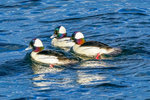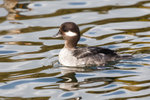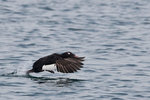

 (melanitta perspicillata)_365316604_L.jpg)

Ducks are found worldwide, and because they are excellent flyers, they often migrate long distances between their summer breeding territories and wintering grounds. During the winter, we in southern Puget Sound are visited by large numbers of ducks of many species. In fact, if you check out the duck section of any North American bird book, you will be surprised by what a large proportion of all duck species visit our area.
Ducks earn their living in two broad ways. Many species are diving ducks, going underwater in search of food. The other ducks are called dabblers – they feed on vegetation on or near the water’s surface and I like to call them “puddle ducks.” There are more diving duck species in our area, but the puddle ducks are found in much larger numbers.
However, there is one diving duck that is common and widespread: the Bufflehead. This species is found everywhere, usually in small groups on freshwater and shallow marine water areas. They feed by diving to capture small aquatic organisms and plant material as well.
This is a small duck, about 13 inches (crow-sized), with a large head and a small bill. The male Bufflehead is unmistakable, although he superficially resembles the male Hooded Merganser. He has a large white patch on his head with a white chest and flank and black back. In good light, the male’s head has an iridescent shine. The female is a much duller brownish gray with a round head and a unique white cheek patch.
Why are they called Buffleheads? Well, it seems that in past centuries someone thought the male’s bulbous head resembled that of a buffalo. Hence, the Bufflehead gains a common name.
These birds are usually seen in mixed-sex flocks and begin to pair up in mid-winter. Sometimes you will see males performing displays for several females, perhaps just practicing for the future. We usually see these birds on the water, but they can also be readily identified in flight. The males are boldly black and white with a large white wing stripe. Females also have a smaller white wing patch.
Scoters
Scoters are stocky, relatively large (up to 20 inches) seabirds of similar appearance and life pattern. They breed on lakes in the far northern tundra of both hemispheres and winter in coastal areas further south, including our part of Puget Sound. They feed by diving underwater seeking mussels, small clams and crabs and other invertebrates. Some will take barnacles and limpets from rocks.
Their gizzards grind up these shell-based meals; ultimately, the resulting sand passes through the digestive tract and is eliminated. This is the interesting origin story for at least a portion of the sand that tickles your toes on our local Puget Sound beaches.
There are three scoter species. They are all similar, males are black with a swollen knob at the base of their bills. Females are brown with vaguely white head markings. Although these head markings are distinctive, they are sometimes difficult to decipher; therefore, identification is often based on the males of the flock. The Surf Scoter is our most common scoter. The males are all-black with a bold white patch on the back of his head and forehead and a distinctive orange and white bill. A similar species in the Black Scoter. This all-black male has no white head markings, only a distinctive orange knob at the base of his bill. Black Scoters were once fairly common in our area but now are seldom seen.
The Third scoter species is the White-winged Scoter. Again, the male appears mostly black but has white wing patches. These patches are usually visible when they are on the water, as well as a white comma-shaped mark at the eye and an orangish-white bill knob. Both sexes readily show their white wing patch during flight.
George Walter is environmental program manager at the Nisqually Indian Tribe’s natural resources department; he also has a 40+ year interest in bird watching. He may be reached at george@theJOLTnews.com
Comments
No comments on this item Please log in to comment by clicking here